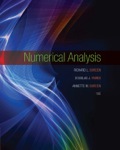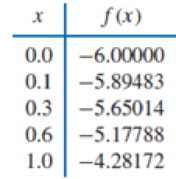
Concept explainers
- a. Use Algorithm 3.2 to construct the interpolating polynomial of degree four for the unequally spaced points given in the following table:

- b. Add f(1.1) = −3.99583 to the table and construct the interpolating polynomial of degree five.
ALGORITHM 3.2
Newton’s Divided-Difference Formula
To obtain the divided-difference coefficients of the interpolatory polynomial P on the (n + 1) distinct numbers x0, x1, … xn, for the function f:
INPUT numbers x0, x1, … xn; values f(x0), f(x1), …, f(xn) as F0,0, F1,0, …, Fn,0.
OUTPUT the numbers F0,0, F1,1, …, Fn,n where
Step 1 For i = 1, 2, …, n
For j = 1, 2, …, i
set
Step 2 OUTPUT (F0,0, F1,1, …, Fn,n);
STOP.
Want to see the full answer?
Check out a sample textbook solution
Chapter 3 Solutions
EBK NUMERICAL ANALYSIS
- Example: For what odd primes p is 11 a quadratic residue modulo p? Solution: This is really asking "when is (11 | p) =1?" First, 11 = 3 (mod 4). To use LQR, consider two cases p = 1 or 3 (mod 4): p=1 We have 1 = (11 | p) = (p | 11), so p is a quadratic residue modulo 11. By brute force: 121, 224, 3² = 9, 4² = 5, 5² = 3 (mod 11) so the quadratic residues mod 11 are 1,3,4,5,9. Using CRT for p = 1 (mod 4) & p = 1,3,4,5,9 (mod 11). p = 1 (mod 4) & p = 1 (mod 11 gives p 1 (mod 44). p = 1 (mod 4) & p = 3 (mod 11) gives p25 (mod 44). p = 1 (mod 4) & p = 4 (mod 11) gives p=37 (mod 44). p = 1 (mod 4) & p = 5 (mod 11) gives p 5 (mod 44). p = 1 (mod 4) & p=9 (mod 11) gives p 9 (mod 44). So p =1,5,9,25,37 (mod 44).arrow_forwardCan you answer this question and give step by step and why and how to get it. Can you write it (numerical method)arrow_forwardJamal wants to save $48,000 for a down payment on a home. How much will he need to invest in an account with 11.8% APR, compounding daily, in order to reach his goal in 10 years? Round to the nearest dollar.arrow_forward
- r nt Use the compound interest formula, A (t) = P(1 + 1)". An account is opened with an intial deposit of $7,500 and earns 3.8% interest compounded semi- annually. Round all answers to the nearest dollar. a. What will the account be worth in 10 years? $ b. What if the interest were compounding monthly? $ c. What if the interest were compounded daily (assume 365 days in a year)? $arrow_forwardKyoko has $10,000 that she wants to invest. Her bank has several accounts to choose from. Her goal is to have $15,000 by the time she finishes graduate school in 7 years. To the nearest hundredth of a percent, what should her minimum annual interest rate be in order to reach her goal assuming they compound daily? (Hint: solve the compound interest formula for the intrerest rate. Also, assume there are 365 days in a year) %arrow_forwardTest the claim that a student's pulse rate is different when taking a quiz than attending a regular class. The mean pulse rate difference is 2.7 with 10 students. Use a significance level of 0.005. Pulse rate difference(Quiz - Lecture) 2 -1 5 -8 1 20 15 -4 9 -12arrow_forward
- There are three options for investing $1150. The first earns 10% compounded annually, the second earns 10% compounded quarterly, and the third earns 10% compounded continuously. Find equations that model each investment growth and use a graphing utility to graph each model in the same viewing window over a 20-year period. Use the graph to determine which investment yields the highest return after 20 years. What are the differences in earnings among the three investment? STEP 1: The formula for compound interest is A = nt = P(1 + − − ) n², where n is the number of compoundings per year, t is the number of years, r is the interest rate, P is the principal, and A is the amount (balance) after t years. For continuous compounding, the formula reduces to A = Pert Find r and n for each model, and use these values to write A in terms of t for each case. Annual Model r=0.10 A = Y(t) = 1150 (1.10)* n = 1 Quarterly Model r = 0.10 n = 4 A = Q(t) = 1150(1.025) 4t Continuous Model r=0.10 A = C(t) =…arrow_forwardThe following ordered data list shows the data speeds for cell phones used by a telephone company at an airport: A. Calculate the Measures of Central Tendency from the ungrouped data list. B. Group the data in an appropriate frequency table. C. Calculate the Measures of Central Tendency using the table in point B. D. Are there differences in the measurements obtained in A and C? Why (give at least one justified reason)? I leave the answers to A and B to resolve the remaining two. 0.8 1.4 1.8 1.9 3.2 3.6 4.5 4.5 4.6 6.2 6.5 7.7 7.9 9.9 10.2 10.3 10.9 11.1 11.1 11.6 11.8 12.0 13.1 13.5 13.7 14.1 14.2 14.7 15.0 15.1 15.5 15.8 16.0 17.5 18.2 20.2 21.1 21.5 22.2 22.4 23.1 24.5 25.7 28.5 34.6 38.5 43.0 55.6 71.3 77.8 A. Measures of Central Tendency We are to calculate: Mean, Median, Mode The data (already ordered) is: 0.8, 1.4, 1.8, 1.9, 3.2, 3.6, 4.5, 4.5, 4.6, 6.2, 6.5, 7.7, 7.9, 9.9, 10.2, 10.3, 10.9, 11.1, 11.1, 11.6, 11.8, 12.0, 13.1, 13.5, 13.7, 14.1, 14.2, 14.7, 15.0, 15.1, 15.5,…arrow_forwardA tournament is a complete directed graph, for each pair of vertices x, y either (x, y) is an arc or (y, x) is an arc. One can think of this as a round robin tournament, where the vertices represent teams, each pair plays exactly once, with the direction of the arc indicating which team wins. (a) Prove that every tournament has a direct Hamiltonian path. That is a labeling of the teams V1, V2,..., Un so that vi beats Vi+1. That is a labeling so that team 1 beats team 2, team 2 beats team 3, etc. (b) A digraph is strongly connected if there is a directed path from any vertex to any other vertex. Equivalently, there is no partition of the teams into groups A, B so that every team in A beats every team in B. Prove that every strongly connected tournament has a directed Hamiltonian cycle. Use this to show that for any team there is an ordering as in part (a) for which the given team is first. (c) A king in a tournament is a vertex such that there is a direct path of length at most 2 to any…arrow_forward
- Use a graphing utility to find the point of intersection, if any, of the graphs of the functions. Round your result to three decimal places. (Enter NONE in any unused answer blanks.) y = 100e0.01x (x, y) = y = 11,250 ×arrow_forwardhow to construct the following same table?arrow_forwardThe following is known. The complete graph K2t on an even number of vertices has a 1- factorization (equivalently, its edges can be colored with 2t - 1 colors so that the edges incident to each vertex are distinct). This implies that the complete graph K2t+1 on an odd number of vertices has a factorization into copies of tK2 + K₁ (a matching plus an isolated vertex). A group of 10 people wants to set up a 45 week tennis schedule playing doubles, each week, the players will form 5 pairs. One of the pairs will not play, the other 4 pairs will each play one doubles match, two of the pairs playing each other and the other two pairs playing each other. Set up a schedule with the following constraints: Each pair of players is a doubles team exactly 4 times; during those 4 matches they see each other player exactly once; no two doubles teams play each other more than once. (a) Find a schedule. Hint - think about breaking the 45 weeks into 9 blocks of 5 weeks. Use factorizations of complete…arrow_forward
- Algebra & Trigonometry with Analytic GeometryAlgebraISBN:9781133382119Author:SwokowskiPublisher:Cengage
 College Algebra (MindTap Course List)AlgebraISBN:9781305652231Author:R. David Gustafson, Jeff HughesPublisher:Cengage Learning
College Algebra (MindTap Course List)AlgebraISBN:9781305652231Author:R. David Gustafson, Jeff HughesPublisher:Cengage Learning

